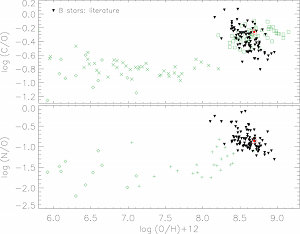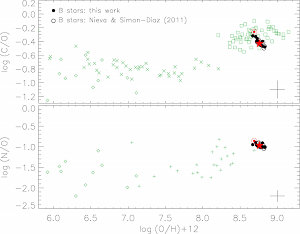|
|  |
The formation and evolution of all objects in the universe, galaxies, stars,
interstellar gas and dust, planetary systems, and even life, are tightly
related to the origin and evolution of the chemical elements and therefore
to the cosmic cycle of matter. Theories related to these phenomena hence
need to be anchored to certain reference values for chemical abundances,
traditionally chosen to be those of the Sun. However, whenever the current
state of the chemical evolution of cosmic matter is of interest, B-type
stars are better indicators. They allow an accurate spatial and temporal
mapping of element abundances, providing a snapshot of the chemical
composition of nearby stellar nurseries at the present day. B-stars are
also preferable over some other present-day abundance indicators
accompanying massive star formation, the H II regions. This is because
the heavy elements in these luminous gaseous nebulae are partially
depleted onto dust grains, which is difficult to quantify.
Nieva and Przybilla have performed a comprehensive study of a carefully
selected sample of early B-type stars in the solar neighbourhood, shown
schematically in Fig. 1. Various telescopes in the Northern and Southern
hemisphere were used to obtain high-quality spectra of the sample stars.
With this new data, sophisticated non-local thermodynamic equilibrium models,
and a novel self-consistent analysis method, the stellar parameters and
chemical abundances of these 29 massive stars could be derived with
unprecedented accuracy and precision.
One of the most surprising results is that the stars analysed in this
study show a high level of chemical homogeneity (varying only about 10%, see Fig. 2).
This is independent of their location, does not depend on whether they are
members in an OB association or field stars, and is also regardless of their
temperature (15000 to 35000 K), mass (6 to 20 solar masses) and age
(about 5 to 50 million years). This high degree of chemical homogeneity
agrees with studies of absorption lines in the interstellar medium,
but challenges all previous work on B-type stars in our Galactic
vicinity, which claim a scatter of elemental abundances by a factor of 2 to 3.
The high degree of homogeneity lead Nieva and Przybilla to propose a
present-day cosmic abundance standard (CAS) based on B-stars in the
solar neighbourhood. Comparing these to the equally accurate solar
abundances, one can identify similarities and differences in the abundances
for individual elements that are of relevance for various aspects of
astrophysical research. A few examples are detailed below.
One crucial test concerns the evolution of massive stars, which for
the first time has been passed successfully for this kind of stars.
The abundances of carbon, nitrogen and oxygen at the surface of the
sample stars follow tightly the expected nuclear path specified by
the CNO-cycle for initial CAS values.
The CAS also puts tight constraints on the composition and evolution
of the local interstellar medium (ISM). By comparing ISM gas-phase
abundances and the CAS, the amount of metals incorporated in the
interstellar dust can be inferred, as only the ISM is affected by
depletion onto dust grains. Moreover, such a study provides important
constraints on the injection and mixing timescales of metals in the ISM.
As the CAS marks the present-day endpoint of chemical evolution in
our galaxy, it provides highly accurate reference values for models
of Galactic evolution (Fig. 3). The improvements achieved in spectral
modelling of the B-type stars are evident in the smaller spread of
abundance values, turning them into valuable precision tools for
astrophysics. Together with results from older, solar-type stars
of various ages, the CAS fits rather well into the established picture
of nucleosynthesis over cosmic time.
When comparing the CAS to abundances of our Sun, the differences are
most prominently seen in the C/O ratio with a disagreement of about 50%.
On the other hand, there is an unexpected agreement between CAS and solar
values for elements such as magnesium, silicon and iron (see Fig. 2).
These elements should be enriched today due to the continuing
nucleosynthesis since the formation of the Sun. This suggests that
the Sun and probably many other older stars in the local vicinity
were not formed here but have migrated to their current environment,
supporting recent findings by colleagues from MPA
 Exploring the history of the Milky Way
that stellar
migration is as an essential ingredient for galactic evolution.
Exploring the history of the Milky Way
that stellar
migration is as an essential ingredient for galactic evolution.
Maria Fernanda Nieva and Norbert Przybilla
Further information:
Nieva, M. F. and Przybilla, N., "Present-Day Cosmic Abundances. A comprehensive study of nearby early B-type stars and implications for stellar and Galactic evolution",
submitted to Astronomy and Astrophysics
Nieva, M. F. and Simon-Diaz, S., 2011, "The chemical composition of the Orion star-forming region. III. C, N, Ne, Mg and Fe abundances in B-type stars revisited", Astronomy and Astrophysics, in press
|





